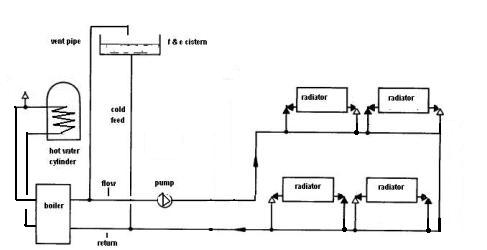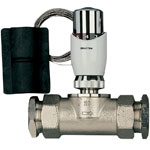Gravity Hot Water Pumped Heating
Natural Convection
This is a very old fashioned way of heating your house, and is only normally found on boilers pre 2000. The water is heated up by means of convection, two large pipes from the boiler go to the hot water cylinder, and as the hot water naturally rises when the boiler heats, the cylinder warms up.
Gravity Hot Water and Pumped Heating to Single Pipe |
|---|
These are very slow and cumbersome, however, there's not much to go wrong on them. They are very expensive systems to run, as they are normally attached to boilers which are very inefficient in the first place. The rest of the system can also be outdated, there may be one pipe feeding all of the radiators, as opposed to two on modern systems, which get the water round the system quicker. The radiators are fed by the pump, and this is normally controlled by the room thermostat. When the heating is switched on, you have no choice but to have hot water, you can't separate them.
Gravity Control
Some systems have very basic hot water controls, such as a Thermostatic "Tap Stat". These are fitted on the pipework to the tank, and give a very primitive control over the temperature in the hot water cylinder. There may be a large brass valve on the return to the tank, called a Cyltrol valve, these are a large brass unit that senses the temperature coming away from the tank and shuts off accordingly.
Tap Stat Control |
|---|
To stop the heating coming on when the boiler fires for hot water only, there is normally a one way valve fitted to the heating flow, or a "Non Return Valve". This only opens when the pump comes on. These can chatter, or can even stick open.
If you have a gravity hot water system, you would be wise to think about upgrading to a fully pumped setup. The pump pushes the water around the circuit a lot quicker, thus reducing energy bills and waiting time for a tank of hot water. You will also gain thermostatic control by upgrading, whereas you are limited by outdated controls on gravity circuits.


